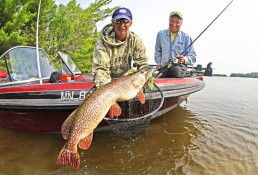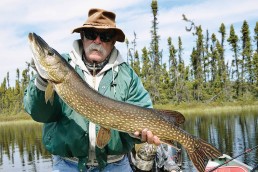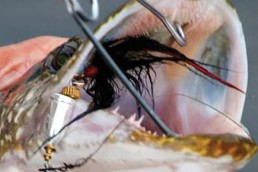Why do Monster Spring Pike get no Respect?
When you hear the statement, “I don’t get no respect,” you might think about the late comic, Rodney Dangerfield. When that phrase is used regarding spring fishing at Lake of the Woods, it pertains to the northern pike.
In April, when most of Minnesota has a closed season for game fish, this area, which is border water with Canada, enjoys extended seasons. While fishing Minnesota waters, there are three opportunities for spring fishing on Lake of the Woods:
- Walleyes on the Rainy River through April 14
- Lake sturgeon, which is open for catch and release or keep season until May 16
- Northern pike, for which the season never closes
Walleyes receive most of the attention, as there is a tradition for many to get out on the Rainy River just as the ice departs. Big populations of walleyes make their way from Lake of the Woods up river to their spawning grounds in the Rainy River. If you hit it right, 100-fish days and multiple fish of a lifetime are possible.
Second on the popularity list is the lake sturgeon. The Rainy River has a strong population of these prehistoric fish and many of them are big. When I say big, I mean up to 80, 90, or even 100 pounds. These fish are starting to be targeted more and more as numbers are up and for many, this might be the largest fish they catch in their lifetime.
Finally, there is the fish that gets the least respect—the northern pike. March is the one month that LOTW pike get some attention. Some pike anglers know this is the time the pike have the feedbags on and get congregated in front of spawning areas. They are targeted with tip-ups and big sucker minnows or dead baits through the ice, and many huge fish are caught this way.
What gets overlooked is the next step in the pike’s journey. Once the pike travel to their spawning grounds and do their business of spawning— in mucky areas, shallow creeks, backwaters, sloughs and bays—they slide out to the adjacent shallow water and begin to recuperate and eventually feed again. This is a great time to target these fish.
Areas to consider for big spring pike
Tributaries and backwaters of the Rainy River:There are a number of big pike caught each year on the Rainy River and the spawning season certainly congregates these big fish in areas that fit the spawning preference of the pike. Look for shallow water with a soft bottom that warms up quickly.
4-Mile Bay and Bostic Creek: This is a big area behind Pine Island on the south shore that extends for miles with depths, for the most part, under seven feet, scattered reed patches and, specifically in the Bostic Creek area, some nice backwater with a mud bottom. Naturally, these areas are also popular for the March pike fishing through the ice and don’t see many anglers once the ice disappears. Yet, pike remain abundant here.
Zippel Bay: This area is the size of an inland lake, with shallow water and a variety of aquatic vegetation. Big pike come into the bay when there is still ice. When the water begins to warm and flow, the pike head into the streams and backwaters leading into the bay to spawn. Some pike will also spawn on the edges of the bay. According to Nick Painovich, owner of Zippel Bay Resort since 1977, you can actually hear when the pike are spawning.
“When the time is right, you can actually hear them in the cattails splashing around,” says Painovich. “In the old days, when there was less draining of the fields, the ditches would fill up with that warm spring water and the pike would actually head up the current of the ditches. You could drive down the road and see pike swimming. The ditches would be full of them. Now, they stay in the creeks, backwaters, and in the bay. There is still a pile of pike out there, and depending upon the year, we catch them into May.”
There are certainly other areas of the lake with pike, but when the conversation is about April and early May, backwaters off of the main lake warm up quicker, will be ice-free quicker, and attract the spawning pike in good numbers.
Go-to baits for early pike
Live bait and dead bait: “After those pike spawn, they are lethargic,” explains Painovich. “A dead bait seems to be the most effective. A midsized smelt is the best. Ciscoes are good, but often times they are larger in size and anglers get pickups, but a lot of missed hook sets. Live sucker minnows can be good, but you need to clip the tails so they can’t swim to the side so easily.”
Anglers use a variety of rigs for their bait. Some use a quick strike rig like they do for ice fishing. This is a leader material that Y’s off with two treble hooks. One treble is hooked just behind the head of the bait and the other just in front of the tail. The key here is to make sure the bait hangs horizontally. Pike like to hit it from the side.
Another go-to rig is a treble hook with a spinner blade on a leader. The leader can be heavy fluorocarbon or regular wire leader material. This time of year, the water can have a tendency to be a bit clearer, thus some anglers prefer the fluorocarbon leader. Because of Minnesota laws, when using a treble hook, you must use a spinner along with it. It is illegal to use a plain treble hook without a spinner.
These baits are typically fished under a bobber. When the bottom is very soft or full of vegetation, fish the bait a couple of feet off of the bottom. In some cases where there are narrow down areas and a bit of current or a harder sandy bottom, the dead bait can be laid right on the bottom. The pike like to pick it up right off of the bottom.
When your bait is on the bottom or you are in very shallow water, when the bait is picked up, often times your bobber will not actually go underwater but will start moving across the top of the water. If you are using a quick strike rig, you can set the hook immediately. When using a treble hook with a spinner or a single hook, some anglers have seen the pike pick up the bait, swim with it a bit, stop and turn the bait, and then move along. The idea is to make sure the pike has the hook in its mouth when setting the hook, and not just a mouthful of bait. Each day is different and it doesn’t take many misses to try something different and figure out what will work that day.
Lures
As the water warms after the spawn, the smaller pike will be the first to be aggressive toward lures such as spoons, crankbaits and spinnerbaits. Eventually, the “big girls” will play along as well.
Work a good looking shoreline with an electric trolling motor, casting your favorite lure. Action this time of year can be hot and heavy.
For those who say you have to stick to live or dead bait in this cold water, don’t tell Katie Pieper and Katie Berg this. This female duo has won the Zippel Bay Resort annual pike tournament the past two years. The tournament is held the last weekend in April. Pieper and Berg won trolling crankbaits. The tournament is based on weight, and both years they had fish over 40 inches to help their cause.
Minnesota DNR information from a 2013 fisheries lake survey verifies the presence of a healthy trophy pike fishery:
“Lake of the Woods is managed for a high-quality northern pike population, with a significant a
component of ‘trophy’ northern pike over 40 inches long. To monitor the size structure of the northern pike population, it is sampled every five years using trap nets at known spawning sites. The northern pike population continues to be one of high quality, with 19 percent of the adult population at least 35 inches long, and five percent of the adults 40 inches long, or longer.”
On Lake of the Woods and the Rainy River, you can keep three pike per day. All pike 30 to 40 inches must be released immediately, with one fish over 40 inches allowed in possession. This means you can keep the smaller variety for the frying pan. With a trophy pike over 40 inches, if you aren’t putting it on the wall, please take good care of the fish, take a quick picture and put it back unharmed.
Lake of the Woods is one of the few fisheries in the U.S. that still maintains a healthy population of trophy pike. It is our privilege to enjoy this wonderful natural resource, but at the same time, please respect these fish for future generations.
MWO
SHARE THIS POST
Did you enjoy this post?
You can be among the first to get the latest info on where to go, what to use and how to use it!
Joe Henry
Tournament angler and licensed charter captain Joe Henry fishes and hunts the Midwest. Henry is a media member of AGLOW and writes for numerous publications, creates videos, appears on a variety of outdoor TV and radio shows and is a frequent seminar speaker. Henry is the Executive Director of Lake of the Woods Tourism.




